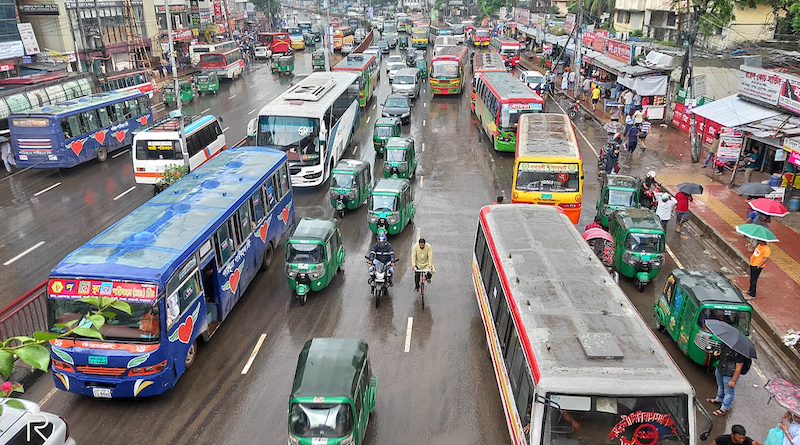Unveiling The Economic Rise Of Bangladesh: A Beacon Of Hope in South Asia – OpEd
By Nazifa Nawar
The European Institute for Asian Studies (EIAS) and Study Circle London jointly organized the conference “EU-Bangladesh Cooperation: Opportunities and the Bengal Tiger Economy” at EIAS in Brussels, Belgium on July 5. The conference was chaired by Lin Goethals, EIAS Director and brought together a number of highly distinguished speakers from different institutions and organizations from Bangladesh and Europe, according to a media release. The conference delves into the progress of Bangladesh’s economy in the last decade.
In recent years, Bangladesh has emerged as a shining star in the global economic arena. The nation, once synonymous with poverty and natural disasters, has undergone a remarkable transformation. Today, it stands as a beacon of hope in South Asia, showcasing an inspiring economic rise that has captured the attention of the world. Against such backdrops, the article explores the key factors that have propelled Bangladesh’s economic growth, the challenges it has overcome, and the potential it holds for the future.
Resilience and Human Capital
Bangladesh’s economic rise can be attributed to the resilience and determination of its people. Despite facing numerous challenges, including frequent natural disasters and a history of political instability, the country has demonstrated remarkable perseverance. The country has to face natural calamities like flood, cyclones, earthquake and other natural as well as man-made natural disasters that incurred 1.8 percent of GDP loss per year. Followed by coups and dictatorships, most of the post-independent period of the country faces political instability till 2008. The more or less political stability in the last decade is one of the key elements in attaining a positive economic uptrend.
Moreover, Bangladesh has invested significantly in human capital, with a focus on education and healthcare. Bangladesh introduced the stipend in 1994 with the support of development partners to increase female secondary school enrolment. Various other incentives were also taken that is well paid off in attaining desired school enrollment. In the health sector, Bangladesh comes a long way in addressing child mortality and pregnancy death, ensuring vaccine for all and community-based healthcare system. For instance, the resolution titled “Community-based primary health care: a participatory and inclusive approach to universal health coverage,” also known as “The Sheikh Hasina Initiative” was adopted unanimously at the UN. This emphasis on empowering its citizens has resulted in a skilled workforce, which has become a driving force behind the nation’s economic growth.
Thriving Garment Industry
The country’s garment and textile industry has played a pivotal role in its economic rise. Bangladesh is now the second-largest exporter of apparel in the world, thanks to its low-cost labor and competitive manufacturing capabilities. The industry has created millions of jobs, particularly for women, empowering them economically and socially.
Furthermore, the government’s efforts to improve workplace safety and compliance have boosted international confidence, attracting foreign investment and fostering sustainable growth. Bangladesh has both the highest rated and the highest number of green garment factories in the world.
Infrastructure Development
Bangladesh has made significant strides in infrastructure development, a crucial element in driving economic growth. The government has prioritized investment in transportation networks, power generation, and digital connectivity. The megaprojects including the flagship Padma Bridge and Metro rail projects have already turned the country to the next level of development. Amid the global uncertainties, the way Bangladesh managed to maintain its development trajectory is a surprise to the world.
Infrastructure projects such as bridges, ports, and highways have not only improved domestic connectivity but have also enhanced regional trade and integration. These investments have laid a solid foundation for continued economic expansion and attracted foreign investors seeking to capitalize on the country’s growing potential.
Diversification and Industry Expansion
While the garment industry has been a key driver, Bangladesh has also recognized the importance of diversifying its economic base. The country has taken significant steps to promote sectors such as pharmaceuticals, information technology, agriculture, and tourism.
By encouraging innovation, entrepreneurship, and foreign direct investment in these sectors, Bangladesh aims to reduce its reliance on a single industry, ensuring sustainable and inclusive growth for the future. It has already created over 100 special economic zones (SEZs), high-tech parks and training facilities for the entrepreneurs to cope with the pace of the digital world.
Social Development and Poverty Reduction
Bangladesh’s economic rise has been accompanied by substantial progress in social development and poverty reduction. The government has implemented various social safety net programs, education initiatives, and healthcare reforms, resulting in improved living standards and enhanced human development indicators. In the 65th UN General Assembly (UNGA) Prime Minister Sheikh Hasina holds up the UN award for her country’s remarkable achievement in attaining the Millennium Development Goals particularly in reducing child mortality. The nation’s success in reducing poverty rates is not only a testament to its economic growth but also reflects its commitment to addressing socio-economic disparities and ensuring the well-being of its citizens.
The economic rise of Bangladesh is an inspiring tale of resilience, determination, and strategic policymaking. Through its emphasis on human capital development, diversification, infrastructure investments, and poverty reduction, the nation has charted a trajectory of sustainable growth. While challenges persist, such as income inequality, climate change, and corruption issues, Bangladesh has demonstrated its ability to overcome obstacles and adapt to changing circumstances. As it continues on this path, Bangladesh has the potential to become a regional economic powerhouse and a role model for other developing nations. The world watches with anticipation as this once-impoverished nation rises to new heights, illuminating the possibilities of economic prosperity for all.

